"Decentralization of technology, centralization of power" has become the new norm in the Perp DEX industry.
Written by: WolfDAO
Chapter 1: The Disguise of Power: The Paradox of Technological Decentralization and Power Centralization
The core innovation of modern Perp DEX lies in smart contract execution, on-chain transparency, and user self-custody. These technological advantages form a "decentralized" defense cloak, yet they often obscure deeper levels of power concentration.
1.1 The Trap of Power Concentration: The Hidden Monopoly of Economic Models and Governance Structures
Although projects claim to be community-governed, token distribution has determined the centralization of power from the very beginning. The majority of governance tokens are concentrated in the hands of founding teams, early investors, and VCs, turning the so-called "democratic governance" into a performance for a few major players.
More importantly, liquidity is the lifeline of Perp DEX, and it is highly monopolized by professional market makers and institutional LPs. Ordinary users find it difficult to compete in the "Matthew Effect" of fee sharing and governance rewards, and the high proposal costs further exclude small investors from governance thresholds, making democracy an illusion.
Chapter 2: The Invisible Hand: Market Manipulation Under Four Mechanisms
Centralized capital does not directly attack the technical architecture but instead establishes structural inequalities to achieve deep control over the market and users.
2.1 Monopoly: Capital-Driven Oligopolistic Market Structure
The Perp DEX market in 2025 shows astonishing concentration: the top four platforms (Hyperliquid, Aster, Lighter, edgeX) collectively control up to 84.1% of the market share.
This extreme concentration is not the result of natural market selection but rather a product of capital filtering and bias. For example, Aster gained nearly 10% market share shortly after its TGE, and its "airdrop success" fully demonstrates that background and capital play a far more decisive role than technological innovation. Large platforms attract more fees and resources through scale advantages, creating a positive feedback loop that establishes almost insurmountable liquidity barriers. In the current deteriorating financing environment, this oligopolistic structure is further solidified, squeezing the survival space for new projects.
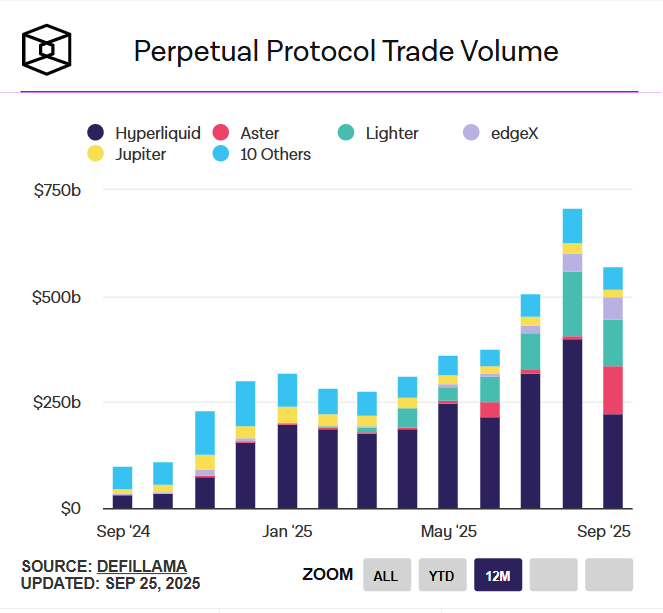
source: theblock
2.2 Intervention: Double Standards in Governance and Trade-offs of Interests
The most brutal manifestation of governance centralization is the selective intervention mechanism. Two classic cases from Hyperliquid clearly reveal how procedural justice fails in the face of platform self-interest.
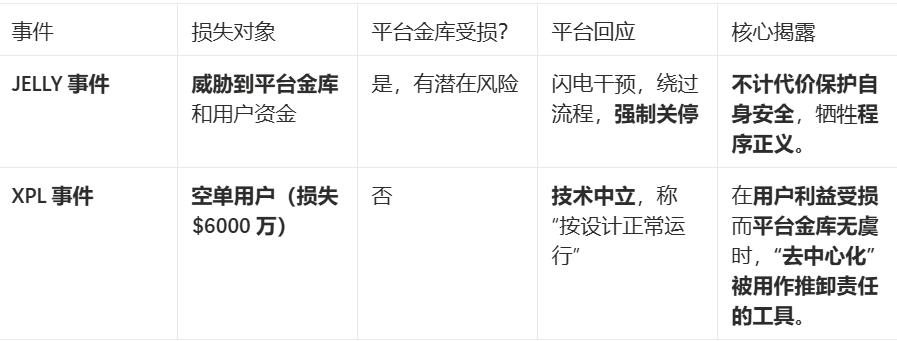
The platform is not choosing whether to intervene or not; it is selectively exercising centralized power to ensure its interest structure is not threatened. Users' losses of tens of millions of dollars are seen by the platform as "market risk," while potential losses for the platform require urgent rescue by violating decentralization principles.
The Lightning Intervention in the JELLY Incident: When the JELLY token faced significant price manipulation, directly threatening platform liquidity and user treasury funds, Hyperliquid's response was remarkably swift. Validator nodes quickly reached an emergency consensus, bypassing all normal governance processes, directly initiating on-chain voting, and forcibly closing profitable orders, shutting down the relevant manipulation accounts. The platform explained that this action was taken to protect user treasury funds from loss, showcasing astonishing execution efficiency.
The Indifferent Response in the XPL Incident: In stark contrast, when manipulators profited over $46 million through a carefully orchestrated short squeeze in the XPL market, causing total losses of about $60 million for short sellers (far exceeding the $11 million loss in the JELLY incident), Hyperliquid's attitude was entirely different.
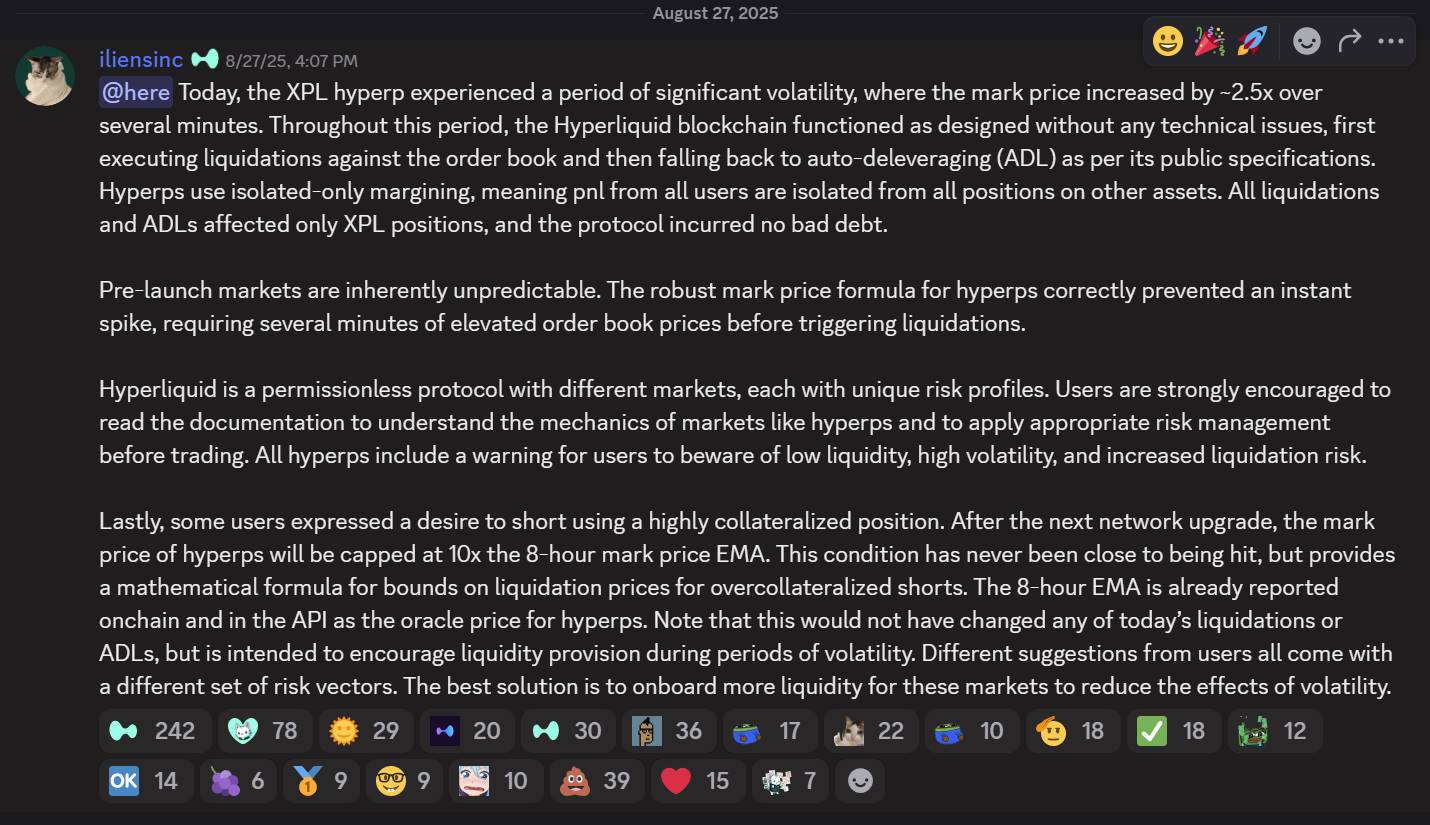
source: hyperliquid discord
The platform responded in its official Discord: "The XPL market experienced severe volatility, but the Hyperliquid blockchain operated normally as designed, with no technical issues. Liquidation and automatic reduction mechanisms were executed according to public protocols, and since the platform employs a fully isolated margin system, this incident only affected XPL positions, and the protocol did not incur any bad debts."
In this capital feast, manipulators carefully exploited Hyperliquid's structural weaknesses:
First, the extreme on-chain transparency allows manipulators to precisely calculate the required funds and expected effects;
Second, the isolated oracle system means that XPL adopts an independent pricing system on Hyperliquid, allowing manipulators to freely manipulate prices within this "walled city" without worrying about price balancing pressure from external exchanges;
Third, they chose unlaunched "paper contract" tokens, which do not face spot delivery constraints;
Fourth, they precisely selected the weakest liquidity timing.
The Double Standards of Interest Calculation Logic: This starkly different handling exposes a clear interest calculation formula: The JELLY incident threatened the platform treasury, triggering intervention; the XPL incident only harmed user interests without affecting the platform treasury, leading to a choice to ignore. The platform's own financial security is always the top priority, and the so-called decentralization principle is merely a decoration when it does not threaten the platform's core interests. Users' $60 million loss is seen by the platform as just "market risk," while potential losses for the platform require urgent rescue by violating decentralization.
2.3 Structure: Protocol-Level Privileges and Liquidity Monopoly
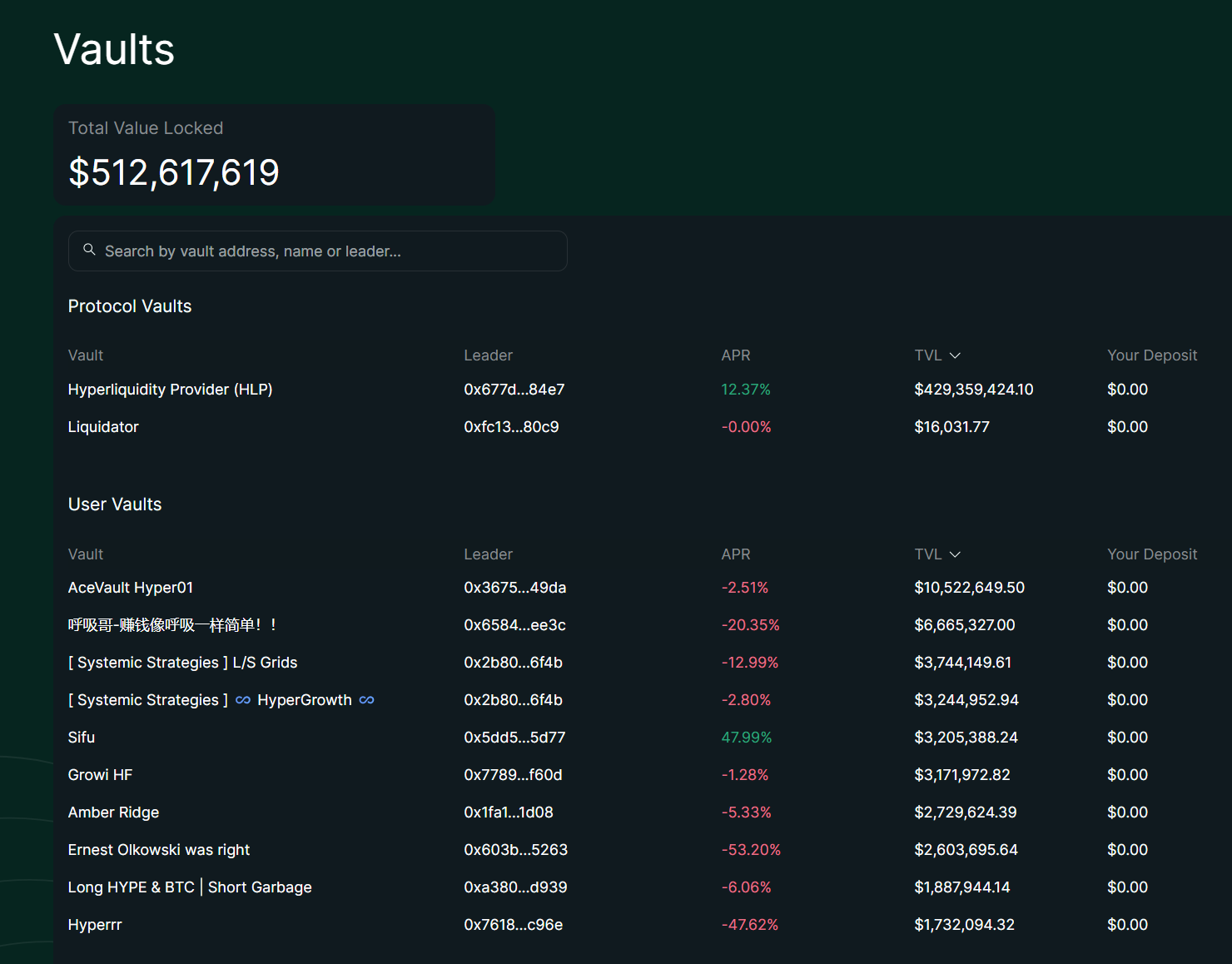
source: hyperliquid
According to the latest data, Hyperliquid's total TVL reaches $512 million, with the protocol treasury HLP accounting for $429 million, or 84%. It has become the protocol's "shadow central bank" or "privileged class." In contrast, all User Vaults combined amount to about $83 million, scattered across hundreds of independent vaults.
In-Depth Analysis of HLP's Systemic Advantages
Monopoly Mechanism of Liquidation Processing: HLP enjoys unique liquidation processing rights. When leveraged positions are liquidated and the order book cannot fully match, HLP absorbs the remaining positions with about 2x leverage and gradually closes them through market-making strategies. This mechanism not only avoids platform-level cascading liquidations but also directly allocates liquidation profits to HLP holders. In contrast, User Vaults cannot participate in backup liquidations and are limited to custom trading strategies.
Structural Advantages in Fee Sharing: HLP extracts about 45% of the fees from the platform's overall trading volume, providing stable passive income correlated with trading volume. Data from the first half of 2025 shows that HLP obtained a significant share of the platform's cumulative income through this mechanism, while User Vaults rely solely on the performance of their Leaders' strategies, with no fixed sharing rights.
Collective Buffer for Risk Management: HLP achieves risk-sharing through a collective fund pool of over $400 million, and off-chain strategy optimization further reduces volatility. Data shows that HLP's volatility is far lower than BTC's 45%, allowing it to maintain relative stability in bull and bear markets, with an annualized return of about 51%. In contrast, User Vaults are easily impacted by the failure of a single strategy.
Systemic Constraints Faced by User Vaults
Structural Disadvantage in Information Access: Leaders of User Vaults have relatively limited access to market data and cannot prioritize order flow or micro-structural information like HLP. HLP's protocol-level integration allows for real-time data feeds, while User Vaults rely on on-chain queries, which are prone to delays.
Technical Gap in Execution Efficiency: In Hyperliquid's sub-second environment, User Vaults face significant latency disadvantages, especially in high-frequency trading or arbitrage opportunities. While Leaders can make off-chain adjustments, on-chain execution requirements limit response speed, making it easier to miss opportunities compared to HLP's infrastructure priority.
Profit Pressure from Cost Structure: Leaders charge 10-20% management/performance fees, directly impacting depositors' returns. This increases operational pressure, especially in volatile markets, while HLP has no such fees and shares profits solely through collective PnL.
Strategy Limitations from Transparency Requirements: On-chain execution requires all positions and trades to be public, enhancing auditability but limiting the flexibility and confidentiality of strategies. HLP's "transparent opacity" design (off-chain strategies + on-chain positions) better balances both aspects.
These systemic advantages make HLP the platform's "default market maker," accounting for 84% of total TVL. In contrast, the operational constraints faced by User Vaults lead to most 30-day PnL being negative (ranging from -2.51% to -53.20%), with TVL only accounting for 16% of the total. This structural difference is not only reflected in performance but also highlights the implicit inequality between protocol-level and user-level participants.
2.4 Penetration: The "Changing Vests" Game of CEX Capital and Ecological Hunting
The Extension of the Binance Empire's Tentacles
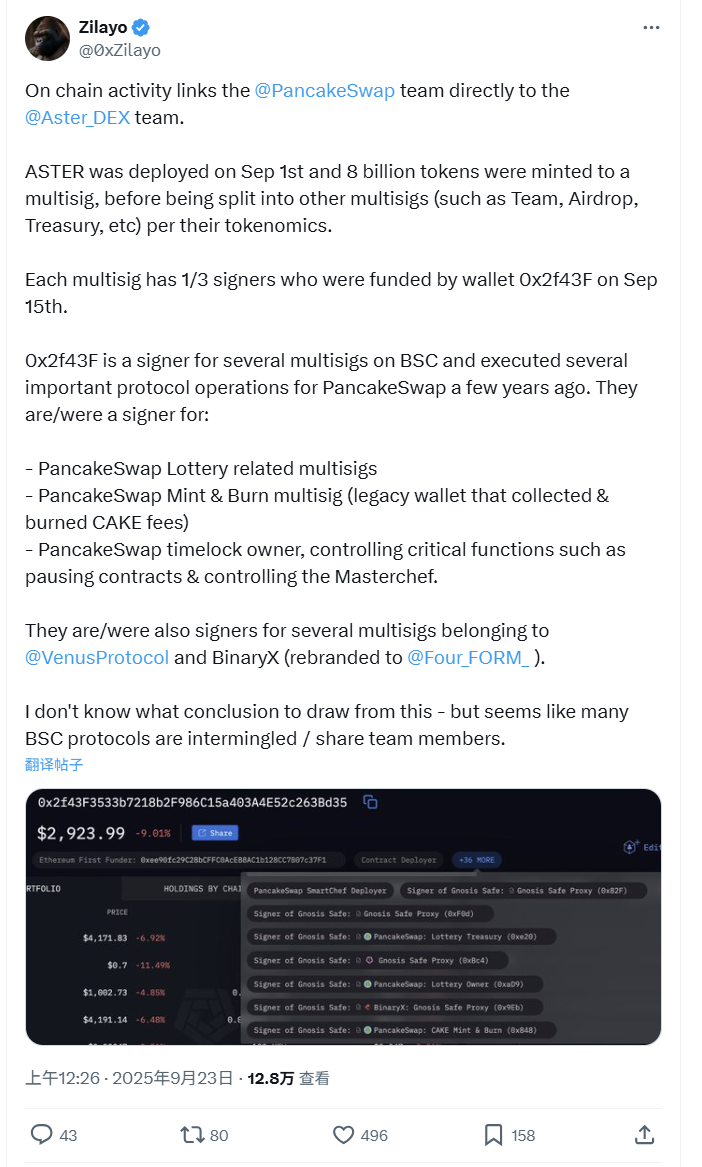
source: @0xZilayo & @awesomeHunter_z
Through in-depth investigations by on-chain detective @0xZilayo and the "haircut dog" @awesomeHunter_z, it has been discovered that:
The recently popular Aster and PancakeSwap are backed by the same team.
Core Control Wallet: 0x2f43F3533b7218b2F986C15a403A4E52c263Bd35
Scope of Control:
Aster Treasury Multisig Contract: 0xEf0791f8dF081c7e6374EE6e9F4c3aBA7C1b1852
PancakeSwap: Direct participation in CAKE token mint/burn operations
Venus Protocol: Multisig wallet controller of the BSC chain lending protocol
Aster Governance System: Core aspects such as token deployment, airdrops, and team wallets
This is no longer a simple "association," but rather different projects of the same operating team.
This also explains why CZ has frequently supported Aster recently: this is not just an investment endorsement, but a promotion for their own product. Aster is essentially an internal project of the Binance ecosystem, and CZ's tweets are a marketing operation of "transferring from one hand to the other."
Personnel Network: Project Division of Binance Executives

source: @_FORAB X
Aster Team Composition:
APX Team: Former core members of APX Finance
Leonard: Head of Binance OTC, responsible for large trades and institutional clients
StandX Team Composition:
Aaron Gong: Former head of Binance contracts
Justin: Former director of Binance contracts
Precision Design of Dual Monopoly:
Product Differentiation: Aster focuses on cross-chain diversification, while StandX specializes in deepening the BNB ecosystem
Risk Diversification: Different legal entities and technical architectures reduce regulatory risks
Market Coverage: Regardless of which succeeds, Binance is the ultimate beneficiary
Other CEXs' Sequential Layouts
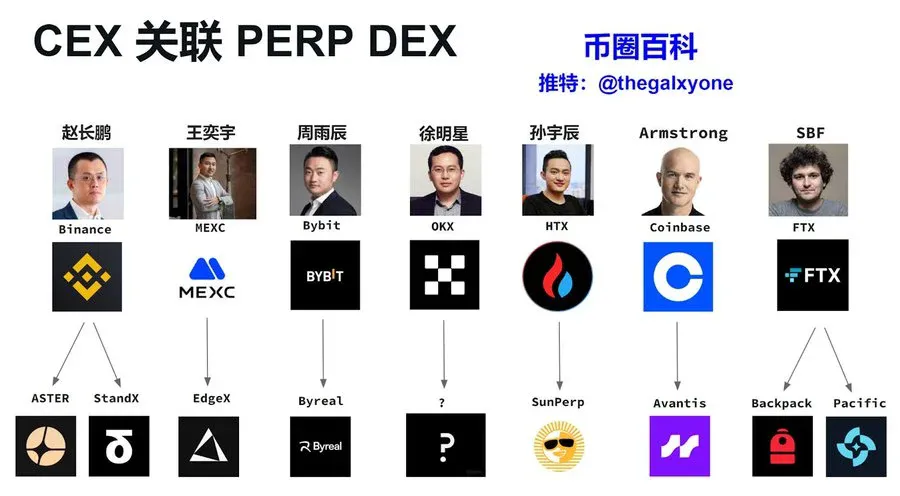
source: X Cryptocurrency Encyclopedia @thegalxyone
Perp DEX Layout Logic of Various CEXs:
MEXC → EdgeX: Under the leadership of Wang Yiyu, MEXC is known as the "king of small tokens." EdgeX focuses on ZK-Rollup perpetual DEX, with a technical route echoing MEXC's flexible listing strategy. EDGEX is a startup project of former executives, and both parties still maintain close ties.
Bybit → Byreal: Bybit has been deeply involved in the derivatives trading field for many years. Byreal inherits Bybit's technical accumulation in perpetual contracts, packaging it as "decentralized" to avoid regulatory risks.
HTX → SunPerp: Sun Yuchen's HTX (formerly Huobi) lays out through the TRON ecosystem. SunPerp utilizes the low-cost advantages of the TRON network, reflecting Sun Yuchen's consistent "ecological closed-loop" strategic thinking.
Coinbase → Avantis: Led by Armstrong, Coinbase represents the U.S. compliance route. Avantis focuses on RWA perpetual contracts, aligning with the U.S. regulatory environment, achieving a balance between technology and compliance through the Base chain.
FTX → Backpack & Pacific: Although SBF has fallen, FTX's technical genes continue. The former FTX team has been diverted to multiple projects, and Backpack and Pacific may have inherited some of FTX's technical assets.
Motivations for CEXs to Layout Perp DEX
CEX Strategic Map: From Binance investing in Aster and StandX, to MEXC incubating EdgeX, and Coinbase laying out Avantis, the core motivations of various CEXs are highly consistent: regulatory risk avoidance (through the "decentralized" label), defending market share and capturing the next generation of DeFi innovation dividends.
Harsh Reality: CEXs migrate users from CEX to associated Perp DEXs through shared technical resources, unified market-making networks, and traffic guidance mechanisms, achieving user circulation within the same capital group control ecosystem. The so-called "decentralization" revolution may very well be just a "capital disguise" game of traditional centralized powers.
Chapter 3: Ending the Ideological Struggle
"Technological decentralization, power centralization" has become the new norm in the Perp DEX industry.
Leading platforms adhere to DeFi principles in technical architecture, but in actual operations, they have been deeply manipulated by CEX capital and a few oligarchs. They have instrumentalized the narrative of decentralization to achieve the dual goals of efficiency and regulatory avoidance.
The key to winning in the Perp DEX arena is no longer ideological belief, but rather who can best balance the decentralized underlying framework with centralized operational efficiency, providing an excellent user experience close to CEX levels. For the mass market, trading speed, capital efficiency, and smoothness have surpassed the pursuit of pure decentralization ideals.
Therefore, future competition will focus on: who can build a sustainable value capture mechanism while continuing to execute efficient centralized capital strategies under the guise of "decentralization."
免责声明:本文章仅代表作者个人观点,不代表本平台的立场和观点。本文章仅供信息分享,不构成对任何人的任何投资建议。用户与作者之间的任何争议,与本平台无关。如网页中刊载的文章或图片涉及侵权,请提供相关的权利证明和身份证明发送邮件到support@aicoin.com,本平台相关工作人员将会进行核查。



